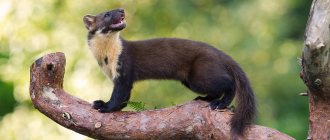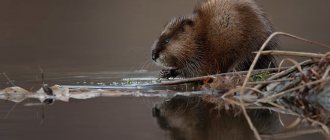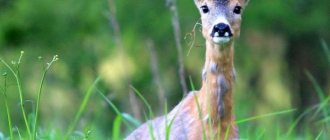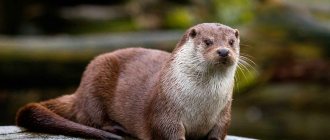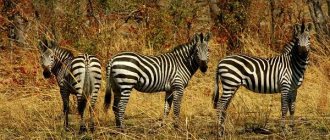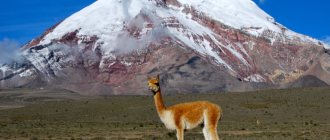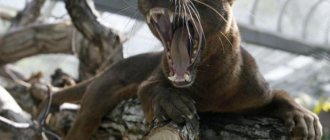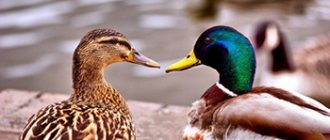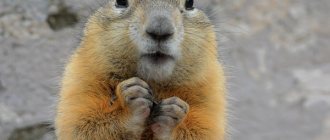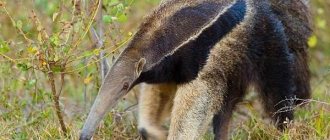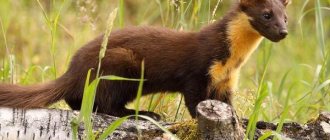Mink is a small predatory mammal from the Mustelidae family. There are 2 species - the European mink lives only in Eastern Europe. The American or eastern mink originally lived only in North America, but was brought to Europe and successfully took root. The animal is known for its beautiful, valuable fur; mink coats are especially prized.
Description and origin of the species
The European mink was first described by Swedish zoologist Carl Linnaeus in 1761, and given the scientific name Mustela lutreola.
The Latin species name Lutreola is derived from the Latin Lutra (otter) and ola (diminutive suffix) and literally means “little otter.” The Russian name “mink” was borrowed from Finnish or Estonian. According to one version, it comes from the word “nurk”, which means ermine, according to another from “nirkka”, or nirk, which translates as weasel.
The closest relatives of the European mink are the European forest ferret and the Siberian weasel. Their close relationship is confirmed by the fact that the animals easily interbreed. Despite their similar appearance, color and habits, and the common name “mink,” European and American minks are not closely related.
The North American mink was first described by German naturalist Johann Schreber in 1777, and given the scientific name Neovison vison. The American species differs from the European one at the cellular level, being closer to martens, so American mink ( Neovison) was separated into a separate genus.
The animal was introduced to Europe in the 1920s and 1930s, and successfully spread throughout the continent. The animal is gradually squeezing its European relative out of its usual habitat. The expansion of the American mink in recent decades is one of the main reasons for the extinction of the European species.
What does a mink look like?
The mink has a classic appearance for the Mustelidae family - a long, flexible, squat body and short legs. Compared to its closest relative, the Siberian weasel, the mink has a more compact body and dense build; in this sense, the animal is closer to the ferret than to martens. The animal's head is relatively large and wide, when compared with other Mustelidae, this animal is also close to the ferret. The tail of the European mink is quite short, accounting for no more than 40% of the body length, while the American species has a longer tail, up to 50% of the body length.
The average body length for male European mink is 373-430 mm, for females 352-400 mm, with a tail of about 150-190 mm. The animal weighs about 550-800 grams. The American mink is noticeably larger - body length up to 50 cm, tail length up to 25 cm, weight up to 2 kg. The paws have membranes between the toes, allowing the animal to dive and swim well. When swimming, the animal pushes with all 4 legs at the same time, and can stay under water for 1-2 minutes.
Mink fur is very thick and dense, much thicker when compared with other representatives of the Mustelidae family, but it is relatively short. The American species has much thicker, longer and softer fur, which is why it is raised on farms more than other fur-bearing animals. Since the animal is a waterfowl, there is practically no difference in length between the hair on the back and on the belly. Summer fur is slightly less dense and slightly shorter, although the difference between summer and winter fur is much less than that of land representatives of the Mustelidae family.
The color varies from reddish-brown to dark brown and even almost black. The color of the animal is uniform, although some individuals have lighter fur on the belly than on the outer parts of the body. In summer, the fur color changes to lighter with a pronounced reddish tint. The European mink has white markings on its upper lip and chin, and patches of white fur are also found on the chest and throat of some individuals. The American mink has white markings only on its lower lip.
Where does the mink live?
Back in the 19th century, the habitat of the European species of animal extended throughout Europe, from northern Spain in the west to the Ob River in the east, and from Arkhangelsk in the north to the northern Caucasus in the south. Over the past 2 centuries, the animal was exterminated by people or squeezed out by the American mink from more than 90% of its former territory.
Now the animal can be found mainly in Eastern Europe:
- Latvia
- Estonia
- Belarus
- Ukraine
- northwest and central regions of the European part of Russia
- Danube Delta in Romania
- northwestern Bulgaria
There are also small, isolated populations in northern Spain and western France. In the Vologda, Tver and Arkhangelsk regions, the animal is on the verge of extinction. The most stable and largest population is located in the Danube Delta - about 1,000 individuals; in Russia, the largest number of animals live in the Central Forest Biosphere Reserve in the Tver region. The animal is found at altitudes of up to 1120 meters at sea level.
The American mink originally lived only in North America; from the beginning of the 20th century, the animal was imported and successfully took root throughout Europe, Siberia, the Far East and Japan. Some individuals have escaped from farms and formed small wild populations in Chile, Argentina and South Africa.
As a habitat, the predator prefers small, remote flowing rivers and streams, with gentle banks overgrown with grass and trees. It is practically not found on large deep rivers; instead, it settles in their tributaries, headwaters, oxbow lakes and estuaries. It also lives in thickets of reeds and reeds on the shores of lakes, ponds, and less often in swamps.
Habitat
The life of the mink is closely connected with fresh water, and therefore it settles along the banks of streams, rivers and lakes, and rarely moves further than 200 m from the banks of the reservoir. The favorite habitats of the mink are the washed-out banks of small rivers and streams overgrown with bushes and forests, as well as oxbow lakes and small lakes. Avoids large open reaches with sandy shores. Sometimes the European mink settles near the mills, not embarrassed by the presence of a person and his activities. In the steppe zone it lives in floodplains and among reed thickets of large rivers. In summer, the mink usually sticks to a certain place and lives for a long time in a small area. Here, under an overhanging, washed-out bank, in the roots or in piles of sediment and windbreaks, she makes her nest and spends the day. When there is an abundance of food, it collects supplies in burrows, dragging there caught fish, snakes, frogs and small animals. Often, having found the top set by the fishermen, the mink drags to itself a lot of fish caught in the net.
What does a mink eat?
Mink feeds on small animals that live in water and coastal areas. The animal's diet includes:
- mouse-like rodents, mainly mice and water rats;
- crustaceans and molluscs;
- frogs, tadpoles and eggs;
- aquatic insects;
- fish - salmon, pike, gudgeon, roach, tench, perch, brown trout, eel, and others;
- birds - gulls, ducks, cormorants, moorhens, coots;
- hares and rabbits.
The American mink's diet is dominated by small mammals, especially rabbits, followed by fish and birds, most commonly moorhens and coots. The European mink feeds mainly on smaller prey - water rats, frogs, crayfish and fish weighing up to 1-1.2 kg. Unlike its more powerful American relative, the European mink rarely catches birds and practically does not hunt hares and rabbits.
The animal eats approximately 140-180 grams of animal food per day. During periods of abundance and before cold weather, the animal makes reserves for the future, depositing carcasses of frogs, fish, and small rodents in a burrow. Unlike the ferret, the mink disdains carrion and eats it only in extreme cases, after 3-4 days of fasting. The animal carries poultry, and often steals fish from fishermen when possible.
Nutrition
Since the mink is a wild animal, a semi-aquatic inhabitant, its food mainly consists of various fish, crustaceans, snails, mollusks, water rats, snakes, and frogs. The animal hunts land animals and birds, and does not disdain insects.
Not far from villages, domestic chickens and ducks often disappear due to the fault of minks. It prefers to eat fresh prey, only during a period of starvation for up to 3-4 days can it switch to stale meat or pick up food waste from houses.
With the approach of cold weather, the mink makes food reserves in the form of bitten or headless frogs, mouse-like rodents, minnows, perches, squints, and occasionally birds. Loves to replenish pantries and takes care of the freshness of savings.
Domestic minks are fed mainly with meat and fish feed with the addition of vegetables, grains, dairy, and vitamin components. An appropriate diet is selected for each biological period. In summer, due to the accumulation of energy, protein and vitamin foods are increased; in winter, less nutritious feed mixtures are used.
Character and lifestyle
Each animal lives in its own territory, but the size of the hunting areas is not too large compared to other representatives of the Mustelidae family, probably because there is more prey in the water than on land. The average territory of the animal is approximately 12-14 hectares; individual individuals occupy up to 60-100 hectares. Along the banks of a river or reservoir, one predator usually accounts for from 250 to 2500 meters of coastline.
The mink has one permanent den and several temporary shelters. It digs burrows on its own, preferring reed beds, old water rat holes or natural depressions. The main hole is used all year round, except during floods, and is located 6-10 meters from the water's edge.
The design of the den is quite simple, and usually consists of one or two passages with a diameter of 8-10 cm, and a length of up to 1.5 meters, leading to a nest measuring approximately 48x55 cm. The floor of the den is lined with dry grass, the hair of prey animals, moss and bird feathers. The European mink leads a more sedentary lifestyle than the American mink, and often sits out the cold in the den.
The animal is active mainly at dusk and at night, but can go hunting during the day. It searches for prey from the shore, walking about 1 km per day in summer, and about 2 km in winter. In the cold season, it prefers to move along trenches dug in the snow and rarely rises to the surface.
The animal swims beautifully, rowing with all its paws at the same time, and in case of danger it dives under the water and swims away 10-20 meters. Copes well with the current. It often hides in aquatic vegetation, holding only its muzzle above the water, and can walk along the bottom. The animal is agile and quite fast. The European mink does not climb trees well, unlike the American mink, which does not experience such difficulties.
Lifestyle
European minks have keen eyesight . The main periods of activity are at dusk (16:00-22:00 hours) and before dawn (05:00-10:00 hours). The European mink leads a more sedentary lifestyle than its American cousin. In extremely cold weather, these mammals do not leave their shelters.
European minks are good swimmers and divers. When swimming, these animals row simultaneously with their front and hind limbs.
Types of mink
As of 2005, 7 subspecies of European mink were officially recognized.
- northern mink M. l.
lutreola. It lives in Finland and in the north of the European part of Russia. - French mink M. l.
biedermanni. Lives in France. - M.l. binominata
- Central European mink M. l.
cylipena. A large subspecies that lives in the Kaliningrad region, Latvia, Lithuania, Hungary and Romania. - Central Russian mink M. l.
novikovi. The animal is medium-sized, slightly larger than the northern mink, while the fur is coarser, shorter and less dense. Lives in Estonia, Latvia, Ukraine, Belarus, and in the south of the European part of Russia. - Carpathian mink Mustela l.
transsylvanica. The smallest subspecies in size, lives in the Balkans, Romania, Moldova, Bulgaria, Hungary. - Caucasian mink M. l.
turovi. Large subspecies with long fur and sparse undercoat. It is found in the Caucasus, in the lower reaches of the Volga and Don, and in eastern Ukraine.
In the wild, minks sometimes interbreed with ferrets, resulting in hybrids called honoriki. These animals are more ferret-like in appearance and habits, and travel further from the shoreline than purebred minks, although they retain the ability to swim well.
The American mink currently has 15 subspecies, depending on the animal's habitat in North America. Given the expanding habitat of the animal, there will likely be more subspecies in the future.
Scientific classification
- Kingdom: Animalia (animals)
- Phylum: Chordata
- Class: Mammalia (mammals)
- Order: Carnivora (predatory)
- Family: Mustelidae (mustelidae)
- Genus: Mustela (weasels and ferrets)
- Species: Mustela lutreola (European mink)
Photo: lutreola.eu
There are seven recognized subspecies of European mink:
- French mink (Mustela lutreola biedermanni) – France;
- Eurasian mink (Mustela lutreola binominata) – Eurasia;
- Central European mink (Mustela lutreola cylipena) – Europe;
- northern mink (Mustela lutreola lutreola) – Europe and Siberia;
- Central Russian European mink (Mustela lutreola novikovi) – Russia;
- Romanian mink (Mustela lutreola transsylvanica) – Romania;
- Caucasian European mink (Mustela lutreola turovi) – Caucasus.
Reproduction and young
During the mating season, the genitals of the female European mink enlarge and change color to mauve. This animal differs significantly from the American mink, whose genitals do not change in any way during the period of estrus. During the rut, males fight for the right to mate with a female, but subsequently do not take any part in the fate of the offspring.
The mating season lasts from February to April, and the American mink always gives birth a month earlier. European mink cubs are born in April-May after 40-43 days of gestation. The American mink, like the skunk, has a unique feature - a short delay in embryo development after conception. Pregnancy of the American species lasts up to 75 days, of which the actual development of the fetus takes only 1 month. The fertilized egg does not enter the uterus immediately, but after a pause of 8 to 45 days, allowing the female to choose the best conditions for the development of the fetus.
One litter usually contains from 3 to 7 cubs, sometimes from different fathers. The puppies are born blind and weigh just 6.5 grams at birth; their weight triples in just 10 days. The eyes open after a month. At 20-25 days, European mink cubs begin to eat solid food, although the mother continues to feed them breast milk until 2-2.5 months. American minks develop faster and feed on their mother's milk for up to 5 weeks.
At the age of 56-70 days, the puppies accompany their mother on the hunt. On days 70-84, young minks become independent and leave their mother. Sexual maturity occurs at the age of 10 months, in time for the next mating season.
Caring for the animal and its offspring
The natural mode of minks is to sleep during the day in a secluded place and hunt at night. The animal usually lives in floodplains and near large bodies of water, because it mainly feeds on fish. Breeders keep animals in cages. They are housed in a specially designated barn.
Important features of animals:
- The main weapon of minks is their teeth. Predators can easily bite right through your palm, so thick gloves are needed to handle them. If trouble happens, the animal bites through the skin and hangs tightly on an arm or leg, grab it by the neck and blow hard into its nose - the grip will weaken.
- The most terrible disease for pets is the Aleutian virus. Symptoms: diarrhea, refusal to eat, ulcers and blood in the mouth. Almost all individuals die.
- Minks do not require special conditions inside their cages. Enough bedding, feeders, and drinking bowls. Don't forget about convenient doors to quickly and painlessly remove your pet from the cage.
- Mating in minks occurs in early spring. By June, the cubs appear. One litter usually contains 6-10 babies. The female warms and feeds them on her own. She will also get rid of the weak herself.
- Mink offspring have a high survival rate. It has been experimentally proven: at -10ºC, babies will fall into a state of suspended animation, but under the influence of any heat they will come to life again.
Natural enemies
The European mink is hunted by the European tree ferret, American mink, red fox, golden eagle and great owl. Foxes generally hunt all representatives of the Mustelidae family, and actively breed in places where there are few wolves and lynxes. Therefore, the more foxes in the region, the fewer minks.
The American mink is a larger and more aggressive animal, so it is less likely to become prey to predators. However, the animal is subject to strong competition from the otter - the animals often live in the same places, which is why the American mink is forced to feed on land mammals more often, yielding fish to the otter.
Interspecies interactions
The main predators of the European mink are humans, the polecat, the American mink, the golden eagle and large owls. This animal was caught for a long time because of its valuable skin. On average, 50,000 individuals were caught annually in the USSR alone.
European minks were caught mainly with the help of dogs and traps. In the fall or early winter, one or two hunters, accompanied by one or more dogs, used nets to catch minks from hiding places along the banks of the stream. In winter, traps and live traps were set for minks.
European mink population
The European mink population is rapidly declining. According to scientists, the number of animals in the wild has decreased by 50% over the past 3 generations, and continues to decline. The decline in mink numbers in Europe began in the 18th century, when the animals disappeared from Germany, Austria and Switzerland. At the beginning of the 20th century, the animals became extinct in the Czech Republic, Poland, Bulgaria and Hungary. In Latvia, Finland and Lithuania, minks were considered extinct, but a few individuals were spotted in the 1990s. In Estonia, Belarus, Moldova and Ukraine, as well as Spain and France, by this time only small fragmented populations remained. In the European part of Russia, mink was found everywhere at the beginning of the 20th century, but the number of animals began to decline rapidly in the 1950-1960s.
The most likely reasons for the decline in the number of European mink:
- reduction of natural habitat due to river drainage and agricultural land expansion. This happened throughout the 19th - 20th centuries throughout Europe - in Germany, Russia, Moldova, Ukraine, Poland, Hungary, the Baltic countries, and others.
- excessive hunting of animals for their valuable fur, especially in Russia. At the beginning of the 20th century, 40-60,000 skins were mined per year in Russia, and about 3,000 in Finland.
- a sharp decline in the number of broad-toed crayfish . These crayfish were almost completely destroyed in Europe due to the crayfish plague.
- stiff competition from American mink. American mink was brought to Europe in 1920-1930. The American species is 20-40% larger than the European species, reproduces a month earlier, and is also not so strongly attached to the shores of reservoirs, so it is easier to adapt to changed living conditions. The number of European minks was falling even before the arrival of American minks, but fierce competition for resources and diseases brought from America accelerated the decline in the population.
Mink is the queen of fur-bearing animals
Thanks to its beautiful and valuable fur, the mink is known all over the world and is considered a real “queen” among fur-bearing animals. The trend of modernity has become the domestication of obstinate animals, which delight not only with their natural charm, but also with their enterprising playful character.
Protection of the European mink species
The animal is included in the international IUCN Red List as a species on the verge of complete destruction. In Russia, it is included in the Red Book of the Russian Federation and in the Red Books of a number of subjects of the Federation - Bashkiria, Udmurtia, Komi, Yamalo-Nenets Autonomous Okrug, Perm Territory, Novgorod, Pskov, Chelyabinsk, Sverdlovsk, Orenburg, Tyumen and Sakhalin regions.
The mink is protected in all countries within its habitat. Genome conservation programs are being implemented in Estonia, Spain, France, Germany, and Romania. In Russia, in the 1980s, more than 300 individuals of the European species were brought to the Kuril Islands of Kunashir and Iturup, in an attempt to save the population from the American mink, but it was not possible to obtain a stable population there.
Economic importance
Today, the European mink has lost its position in favor of the American one, which has successfully taken over its ecological niche. The predator significantly influenced the numerical composition of small carnivorous animals, whose food is identical.
For humans, the harm from a willful fur-bearing beauty consists in its attack on a domesticated bird.
